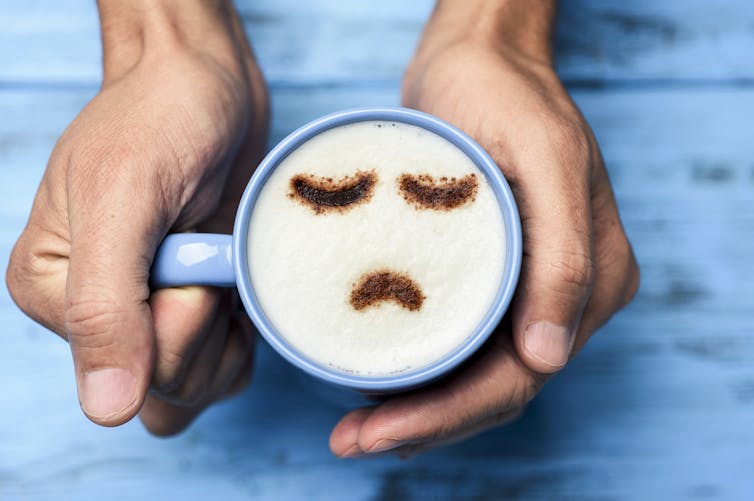Seasonal depression - why it happens and how to manage the symptoms

Harriet Bowyer, Glasgow Caledonian University
With the weather getting colder and the days becoming shorter, some people are noticing they have less energy and aren’t feeling as positive as they usually do. While these feelings may be temporary for some, around one in three people consistently struggle through the autumn and winter months with a type of depression known as seasonal affective disorder (Sad).
Symptoms of Sad can vary from mild to severe, but typically include:
- Low mood,
- Loss of interest or pleasure in things you previously enjoyed,
- Change in appetite (usually eating more than usual),
- Change in sleep (typically too much sleep),
- Feeling worthless.
Researchers aren’t yet clear on what causes Sad, but it’s likely to be complex and multifaceted. Some research suggests it could be due to a malfunctioning hypothalamus (the area of the brain that regulates mood, sleep and appetite) or producing too much melatonin (a hormone that controls our sleep-wake cycle, which is produced by the brain’s pineal gland). Some researchers theorise it could also be due to having a disrupted circadian rhythm – the natural, internal process that regulates our sleep-wake cycle.
Of course, there may be other factors at play too. For example, some research has indicated that women may be more likely to experience Sad – though, due to a lack of specific research, it’s uncertain whether these gender differences really exist and if so, why.
Getting through it
Some people notice that their symptoms start to improve when the seasons begin to change and spring approaches. But this doesn’t mean that there aren’t many things people can do during the winter months to help them cope with their symptoms.
For people with Sad, the main recommended treatments include psychological interventions (such as talking therapies) or taking medication (such as an antidepressant). Research shows that cognitive behavioural therapy (which focuses on challenging our distressing thoughts and changing our behaviour) is an effective treatment for Sad.
In one study, researchers showed that cognitive behavioural therapy (CBT) was associated with significantly lower depression when followed up one year later when compared to light therapy (another treatment sometimes used for Sad, which involves sitting in front of, or below, a box which emits a very bright light, for around 20-30 minutes or more daily).

A key part of CBT is supporting patients in a technique called behavioural activation, which aims to improve mood by encouraging people to structure their day and engage in meaningful, pleasurable activities – a hobby, for example. Research also indicates that certain antidepressants (specifically SSRIs) may be particularly effective in treating symptoms of Sad.
Light therapy is also being investigated as a treatment for Sad. Given it’s still an emerging therapy, research regarding its effectiveness as a standalone treatment for Sad remains inconsistent. But one study has shown that light therapy can be an effective way of managing Sad symptoms when used in combination with antidepressants. Light therapy is not usually available on the NHS, so if you do want to try it be sure to only choose a product that is medically approved for the treatment of Sad – and follow instructions for use or consult your GP.
Aside from seeking professional help, there are a couple of other things that people can do to help them cope with Sad during their day.
Going outside and getting some natural daylight is one thing people experiencing Sad can do for themselves. According to one study, getting more natural light during the day may help improve symptoms. The researchers of the study had participants either go for a daily one-hour outdoor walk, or use a low-dose artificial light box for 30 minutes per day for a period of one week.
The participants who went for a daily walk showed significant improvements in all depressive symptoms, compared to those exposed to artificial light. While it’s uncertain exactly why daylight may improve symptoms, this may still be an easy and effective thing that people can do to improve their mood each day.
Research also shows that lifestyle factors (such as exercise levels and diet) can play an important role in both causing and managing depression. When it comes to Sad in particular, there’s some evidence to suggest that exercising (on it’s own or in combination with light therapy), may improve symptoms.
Again, it’s still unclear why this is the case. But research has indicated that it may be related to changes in our circadian rhythm. A review that looked at the effect of exercise on depression has pointed to both the psychological (such as exercise providing distraction from negative thoughts and a means to socialise) and physiological (such as changes in endorphin or cortisol levels) benefits.
While there are many things people can do to manage symptoms of Sad throughout the winter months, it’s important to consult your GP about symptoms and feelings – especially if symptoms don’t improve, or if the condition becomes difficult to manage.
If you are struggling or feel you could benefit from mental health support, please speak to your GP, and/or try contacting supportive organisations such as The Seasonal Affective Disorders Association, The Samaritans or Campaign Against Living Miserably (CALM).![]()
Harriet Bowyer, Lecturer in Applied Psychology/Clinical Psychologist, Glasgow Caledonian University
This article is republished from The Conversation under a Creative Commons license. Read the original article.







